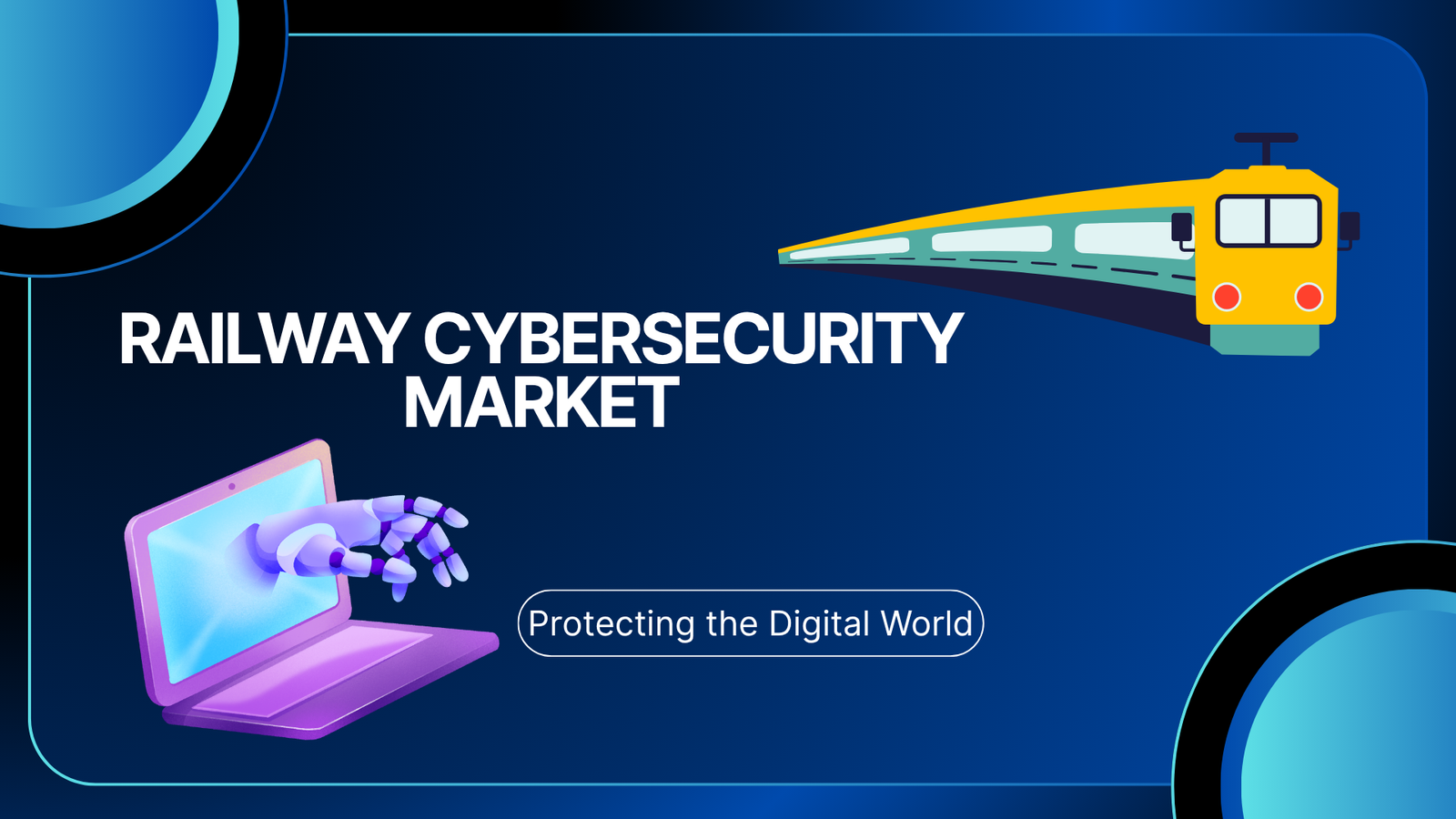Railway Cybersecurity Market to Hit Nearly USD 19.7 Bn By 2034
Updated · Oct 06, 2025

WHAT WE HAVE ON THIS PAGE
Introduction
According to Market.us, The Global Railway Cybersecurity Market is anticipated to rise from USD 8.1 billion in 2024 to USD 19.7 billion by 2034, reflecting a 9.3% CAGR between 2025 and 2034. In 2024, Asia Pacific led the market with 33.9% share, contributing USD 2.7 billion in revenue.
The Railway Cybersecurity Market describes the sector dedicated to protecting railway systems from cyber threats. This includes safeguarding critical infrastructure, communication networks, passenger data, and operational controls integral to rail transport. With railways increasingly adopting digital technologies like IoT, AI, and cloud computing to improve efficiency and passenger services, the exposure to cyberattacks has grown. These attacks can disrupt services, endanger safety, and lead to significant data breaches, driving a continuous need for advanced cybersecurity solutions throughout the industry.
Top driving factors for the Railway Cybersecurity Market include the rapid digitalization and expansion of railway networks worldwide, especially the growth of high-speed rail systems. In countries like China, the network extends over 160,000 kilometers, making cybersecurity essential to protect complex digital infrastructure. Another key factor is the increase in cyber threats targeting transportation systems, ranging from ransomware to hacking attempts. Governments worldwide enforce stricter cybersecurity regulations for rail operators to comply with safety standards, prompting increased investments in cybersecurity defense mechanisms.

Key Insight Summary
- Solutions segment led with 63.5%, underlining the importance of software and platform-based offerings in securing railway systems.
- Network security accounted for 32.3%, reflecting the critical need to safeguard communication and data exchange across railway networks.
- Infrastructure security dominated with 62.2%, emphasizing protection of both physical assets and digital infrastructure.
- Asia Pacific captured 33.9% of revenue, driven by large-scale railway modernization, digital transformation initiatives, and growing cybersecurity investments.
Analysts’ Viewpoint
Demand analysis shows that the rising incidents of cyberattacks and the critical need to protect sensitive passenger and operational data are fueling demand for specialized cybersecurity solutions. The railway sector’s evolutionary integration of digital controls, automation, and smart infrastructure creates more attack surfaces needing comprehensive protection. Moreover, travelers’ increasing reliance on digital ticketing and real-time train tracking amplifies the importance of securing customer data and online systems.
The increasing adoption of technologies such as IoT, Artificial Intelligence, cloud computing, and automated threat detection tools is transforming railway cybersecurity. IoT devices allow rail systems to monitor operations in real time but also introduce vulnerabilities hackers can exploit. AI technologies enhance threat detection by analyzing network traffic patterns to identify abnormalities quickly. Cloud computing supports centralized data management but requires robust encryption and access controls to prevent breaches. These technologies are adopted primarily to improve system resilience against evolving cyber risks and ensure uninterrupted service.
Key reasons for adopting these advanced cybersecurity technologies include protecting critical infrastructure from costly and dangerous cyber incidents, ensuring compliance with regulatory frameworks, and safeguarding passenger privacy. The digital nature of modern railways necessitates proactive defense to avoid service disruptions that could impact millions of daily commuters and freight transport. Additionally, regulations such as the Transportation Security Administration (TSA) directives in the U.S. demand stringent cybersecurity controls, pushing operators toward the latest solutions that offer monitoring, incident response, and continuous compliance.
Investment and Business benefits
Investment opportunities abound in developing innovative cybersecurity platforms tailored to railway operations, including specialized network segmentation, real-time threat monitoring, and zero-trust security models. Collaborations between tech firms and railway operators foster the integration of advanced cybersecurity measures into legacy and new digital rail systems. The rising awareness of cyber risks and government support also create fertile ground for investors focusing on security solutions that address operational technology (OT) and information technology (IT) threats in railways.
Business benefits of investing in railway cybersecurity include enhanced operational continuity, protection of sensitive data, and improved safety for passengers and assets. Effective cybersecurity reduces the risk of costly downtime and reputational damage from cyber incidents. It also streamlines regulatory compliance reporting and audit readiness, which are vital for railway operators facing growing legislative scrutiny. Moreover, advanced cybersecurity creates trust among passengers by protecting their digital interactions and personal data, which contributes to better customer satisfaction.
The regulatory environment for railway cybersecurity is evolving with authorities in major regions setting standards to ensure network and data security. In the U.S., the TSA requires mandatory cybersecurity directives for rail operators, while in Europe, regulatory frameworks are often recommended best practices though becoming stricter. These frameworks emphasize risk assessments, network segmentation, incident response planning, and continuous monitoring. The complexity lies in applying these standards without disrupting rail safety and operations, making compliance a significant but necessary challenge for operators.
Emerging trends
Emerging trends in railway cybersecurity highlight the growing integration of advanced technologies such as AI, IoT, and cloud computing into rail systems. These technologies improve operational efficiency but widen the threat landscape, exposing rail infrastructures to sophisticated cyberattacks. Reports show that cyber attacks against railways are doubling each year, raising urgent pressure on the industry to adopt stronger security frameworks.
There is also a notable increase in attacks targeting operational technology (OT) that controls train movements and signaling. In response, rail operators are deploying network segmentation, identity management, and multi-layered threat defenses to contain attacks and protect critical systems. Furthermore, the rise of connected passenger services like digital ticketing and onboard internet has introduced new vulnerabilities that must be managed carefully to protect passenger data and service continuity. Public concern about passenger safety from cyber threats is also driving investments in comprehensive cybersecurity measures throughout the sector.
Growth factors
Growth factors fueling the expansion of the railway cybersecurity sector include the increasing digitization and connectivity of rail systems worldwide. The adoption of IoT and AI technologies for smarter operations requires robust cybersecurity as railways become more exposed to remote hacking risks. Regulatory initiatives by governments to mandate cybersecurity standards in critical infrastructure further compel the industry to invest heavily in protective solutions.
Urbanization and smart city projects are pushing expansions in railway networks and transit integrations, which add complexity and demand higher security standards. The COVID-19 pandemic initially slowed some development projects due to reduced passenger traffic, but the industry has rapidly rebounded with greater focus on cybersecurity to ensure system reliability. Finally, the ongoing convergence of IT and OT networks increases the exposure of railway control systems to cyber threats, which drives demand for specialized network security and data protection technologies tailored to railway environments.
Key Market Segments
-
By Component
- Solution
- Risk and Compliance Management
- Threat Intelligence and Response
- Identity and Access Management
- Data Loss Prevention
- Others
- Services
- Consulting
- Support
- Integration
- Solution
-
By Security Type
- Application Security
- Network Security
- Data Protection
- Endpoint Security
- System Administration
-
By Type
- Infrastructure
- On-board
-
By Sales Channel
- Passenger Trains
- Freight Trains
- Metro/Monorail
Top Key Players in the Market
- Nokia Networks
- Huawei Technologies
- Cylus
- Cisco Systems
- IBM Corporation
- Raytheon Technologies
- Fortinet
- Thales Group
- Siemens Mobility GmbH
- Alstom
- Hitachi Rail
- ABB
- Toshiba Infrastructure Systems & Solutions
- Wabtec Corporation
- Atos SE
- Others
Source of information @ https://market.us/report/railway-cybersecurity-market/
Sources

Rohan is a senior editor at Techno Trenz. He knows a lot about digital marketing, SEO, and social media optimization. Rohan is great at creating and editing detailed articles with accurate statistics that readers find useful. As a senior editor, he reviews and checks the quality of content from many writers before it is published. He also makes infographics to go with the statistics, making the information easier to understand and more engaging. Rohan's hard work ensures that Techno Trenz provides high-quality and informative content to its readers.










